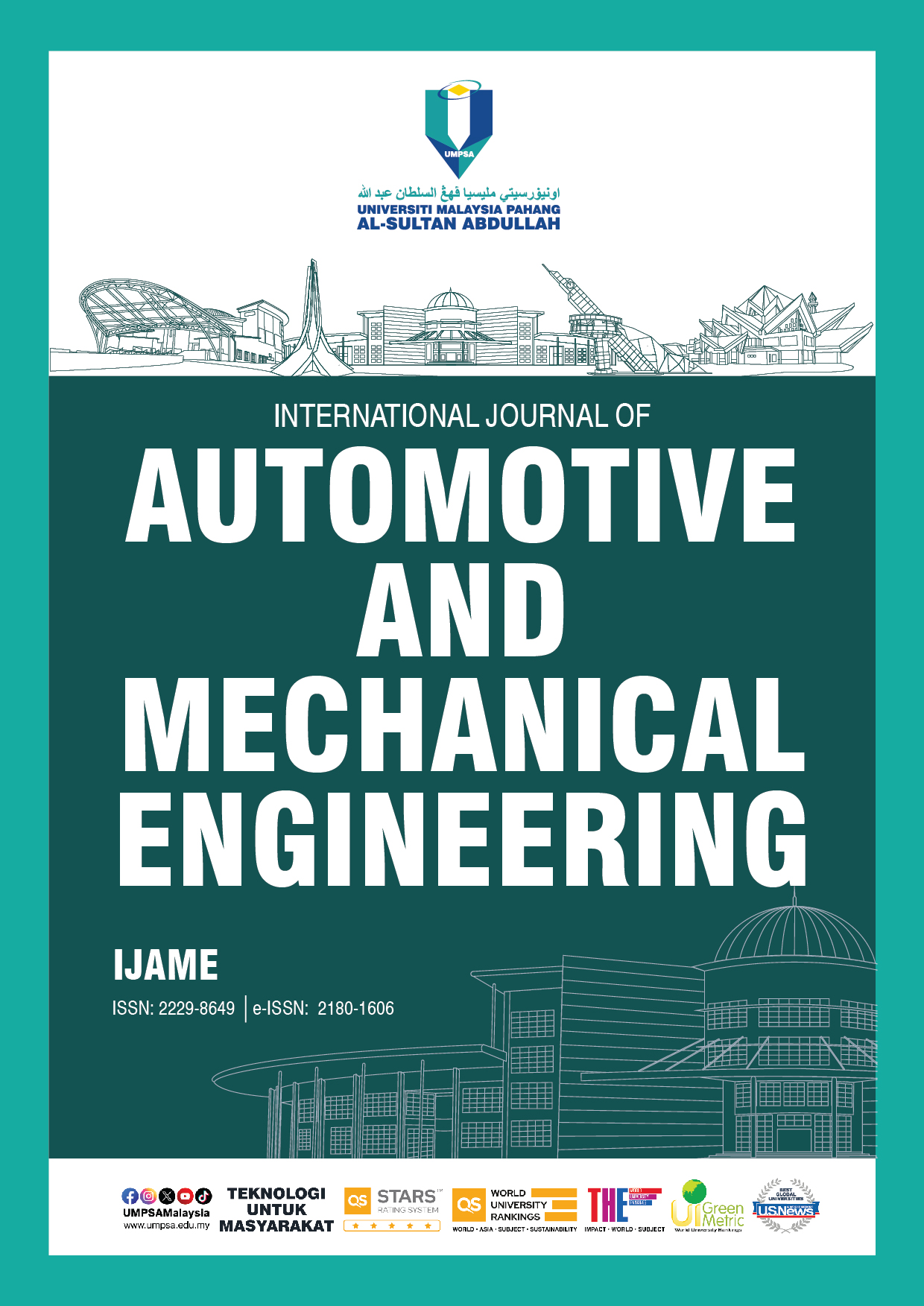Modeling of Creep Behavior in Grade 91 Steel under Complex State of Stress
DOI:
https://doi.org/10.15282/ijame.22.2.2025.3.0940Keywords:
Creep damage, Grade 91, Norton power law, Notch acuity, Rupture lifeAbstract
Power plant components such as boiler tubes, superheated pipes, and headers often operate under elevated temperatures, leading to creep failure. Due to their non-uniform geometries, these components experience complex states of stress. This study investigates the creep rupture characteristics of Grade 91 steel under multiaxial stress conditions, focusing on notched specimens with acuity ratios of 2.28 and 4.56. Creep rupture tests operated at 600°C revealed rupture lives ranging from 52 to 398 hours for the 2.28 acuity ratio and 81 to 890 hours for the 4.56 acuity ratio. Finite element analysis (FEA) incorporating a ductility exhaustion-based damage model predicted rupture lives within a ±2 scatter band of experimental results, demonstrating good agreement. The analysis also highlights those blunter notches show a shift in the locality of extreme damage from the notch root to the ligament center as creep progresses, while sharper notches exhibit localized damage near the notch root. Furthermore, the study establishes the transition between von Mises stress and maximum principal stress-controlled rupture mechanisms. The incorporation of skeletal stress into the Norton power law improved the accuracy of life predictions for non-uniform stress distributions.
References
[1] I. U. Ferdous, N. A. Alang, J. Alias, A. H. Ahmad, and S. Mohd Nadzir, “Rupture life and failure mechanism of Grade 91 steel under the influence of notch constraint,” Journal of Failure Analysis and Prevention, vol. 23, no. 2, pp. 497–510, 2023.
[2] H. Shigeyama, Y. Takahashi, J. Siefert, and J. Parker, “Creep-Fatigue life evaluation for Grade 91 steels with various origins and service histories,” Metals (Basel), vol. 14, no. 2, p. 148, 2024.
[3] B. A. Prajapati and J. A. Penso, “Fabrication of Grade 91 materials experience in oil and gas applications,” in Pressure Vessels and Piping Conference, American Society of Mechanical Engineers, p. V006T06A060, 2020.
[4] A. Tonti, A. Alvino, A. Antonini, C. Delle Site, D. Lega, S. Matera, and et al., “Steel grades 91 and 92 microstructure and precipitate evolution atlas and life assessment tool,” Materials at High Temperatures, vol. 41, no. 2, pp. 222–233, 2024.
[5] N. A. Alang and K. Nikbin, “Creep, fatigue, and creep-fatigue crack growth behaviours of P92 steel at 600 °C,” Strength, Fracture and Complexity, vol. 15, no. 1, pp. 29–45, 2022.
[6] N. A. Alang and K. Nikbin, “Modelling of creep rupture in Grade 92 steel using a microstructure-type finite element mesh,” Key Engineering Materials, vol. 946, pp. 29–34, 2023.
[7] N. A. Alang, L. Zhao, and K. Nikbin, “Evaluation of Monkman–Grant strain as a key parameter in ductility exhaustion damage model to predict creep rupture of Grade 92 steel,” Journal of Strain Analysis for Engineering Design, vol. 57, no. 5, pp. 392–408, Jun. 2022.
[8] D. R. Hayhurst, F. A. Leckie, and C. J. Morrison, “Creep rupture of notched bars.,” Proceedings of the Royal Society A, vol. 360, no. 1701, pp. 243–264, 1978.
[9] G. A. Webster, K. M. Nikbin, and F. Biglari, “Finite element analysis of notched bar skeletal point stresses and dimension changes due to creep,” Fatigue & Fracture of Engineering Materials & Structures, vol. 27, no. 4, pp. 297–303, 2004.
[10] S. Goyal, K. Laha, C. R. Das, and M. D. Mathew, “Analysis of creep rupture behavior of Cr-Mo ferritic steels in the presence of notch,” Metallurgical and Materials Transactions A, vol. 46, no. 1, pp. 205–217, 2015.
[11] J. F. Wen, S. T. Tu, F. Z. Xuan, X. W. Zhang, and X. L. Gao, “Effects of stress level and stress state on creep ductility: Evaluation of different models,” Journal of Materials Science & Technology, vol. 32, no. 8, pp. 695–704, 2016.
[12] N. Bieberdorf, A. Tallman, M. A. Kumar, V. Taupin, R. A. Lebensohn, and L. Capolungo, “A mechanistic model for creep lifetime of ferritic steels: Application to Grade 91,” International Journal of Plasticity, vol. 147, p. 103086, 2021.
[13] I. U. Ferdous, N. A. Alang, J. Alias, and S. M. Nadzir, “Numerical prediction of creep rupture life of ex-service and as-received Grade 91 steel at 873 K,” International Journal of Automotive and Mechanical Engineering, vol. 18, no. 3, pp. 8845–8858, 2021.
[14] T.-Y. Niu, C. Gong, J.-G. Gong, and F.-Z. Xuan, “Creep failure behavior of notched structure in the simulated steam turbine rotor: Experimental and damage analysis,” Journal of Pressure Vessel Technology, vol. 142, no. 6, 2020.
[15] X. Xu, G. Z. Wang, F. Z. Xuan, and S. T. Tu, “Effects of creep ductility and notch constraint on creep fracture behavior in notched bar specimens,” Materials at High Temperatures, vol. 33, no. 2, pp. 198–207, 2016.
[16] L. Zhao, N. A. Alang, and K. Nikbin, “Investigating creep rupture and damage behaviour in notched P92 steel specimen using a microscale modelling approach,” Fatigue & Fracture of Engineering Materials & Structures, vol. 41, no. 2, pp. 456–472, 2018.
[17] K. Yoshida and M. Yatomi, “Creep damage evaluation for HAZ of Mod. 9Cr-1Mo steels under multiaxial stress conditions,” Procedia Engineering, vol. 10, pp. 490–495, 2011.
[18] F. H. Norton, The creep of steel at high temperatures, 1st ed. New York: McGraw-Hill Book Co., 1929.
[19] B. K. Choudhary and J. Christopher, “Influence of temperature and strain rate on tensile deformation and fracture behaviour of boron added P91 steel,” International Journal of Pressure Vessels and Piping, vol. 171, pp. 153–161, 2019.
[20] H. A. Lockwood, M. H. Agar, and S. M. Fielding, “Power law creep and delayed failure of gels and fibrous materials under stress,” Soft Matter, vol. 20, no. 11, pp. 2474–2479, 2024.
[21] N. A. Alang and K. Nikbin, “A new approach to predict creep rupture of Grade 92 steel under multiaxial stress states,” International Journal of Mechanical Sciences, vol. 163, p. 105096, 2019.
[22] G. A. Webster, S. R. Holdsworth, M. S. Loveday, K. Nikbin, I. J. Perrin, H. Purper, et al., “A code of practice for conducting notched bar creep tests and for interpreting the data,” Fatigue & Fracture of Engineering Materials & Structures, vol. 27, no. 4, pp. 319–342, 2004.
[23] N. A. Razak, “Creep and creep-fatigue Interaction in new and service exposed P91 steel,” Thesis, Imperial College London, 2018.
[24] ASTM International Committee E-28 on Mechanical Testing. Standard test methods for elevated temperature tension tests of metallic materials. ASTM International, 2009.
[25] J. J. Han, H. S. Lee, Y. J Kim, N. H. Kim, W. G. Kim, H. Y. Lee, et al., “Prediction of creep crack initiation and growth for P91 at 600°C using MOD-NSW model,” Strength, Fracture and Complexity, vol. 9, no. 1, pp. 125–136, 2015.
[26] K. Sawada, K. Kimura, F. Abe, Y. Taniuchi, K. Sekido, T.Nojima, and T.Ohba et al., “Catalog of NIMS creep data sheets,” Science and Technology of Advanced Materials, vol. 20, no. 1, pp. 1131–1149, 2019.
[27] A. C. F. Cocks and M. F. Ashby, “On creep fracture by void growth,” Progress in Materials Science, vol. 27, no. 3–4, pp. 189–244, 1982.
Downloads
Published
Issue
Section
License
Copyright (c) 2025 The Author(s)

This work is licensed under a Creative Commons Attribution-NonCommercial 4.0 International License.







